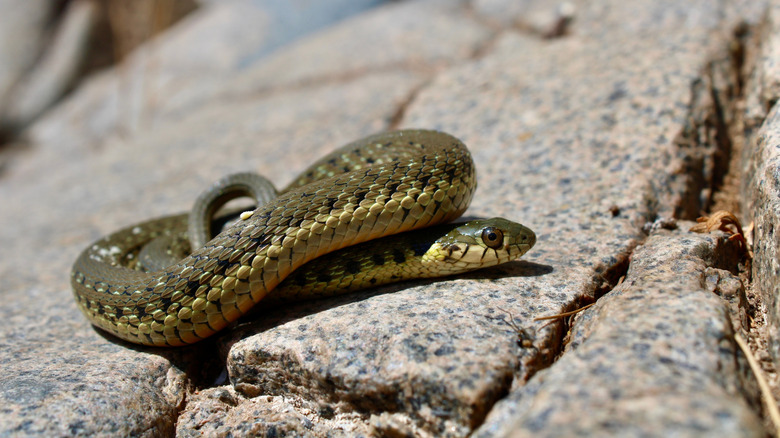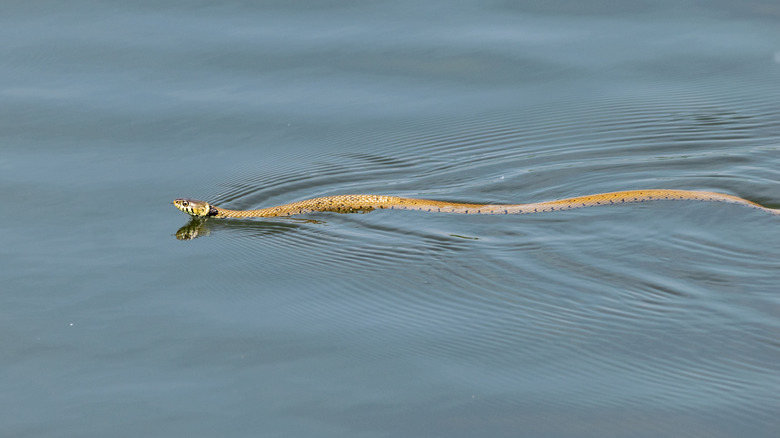The Most Snake-Infested Lakes In Arizona That'll Have You Reconsidering Your Next Swim
When you look for a lake holiday, Arizona may not immediately spring to mind. The state is better known for sprawling forests of cacti, four distinct desert regions, and gateways to the North and South rim of the majestic Grand Canyon. Yet this arid state has a surprising amount of water: 128 lakes and reservoirs as well as five major rivers, to be exact, including the Colorado River that winds through the Grand Canyon. Some of them, like Lake Powell in the Glen Canyon National Recreation Area, are major tourist draws. But venture carefully — Arizona is also home to an incredible diversity of snakes. According to World Population Review, Arizona is has the third-most snake species in the country, tied with Nevada and beat only by Mississippi and Texas. The rattlesnake is perhaps the most well-known of Arizona's snakes, as the state has 13 species of rattlers. And like many of Arizona's other snake species, they can all swim. Using their muscular bodies, snakes undulate on the surface to propel themselves forward and can go a surprising distance. They can also dive underwater and able to hold their breath for up to 45 minutes.
There are many reasons you might see a snake swimming near you, said Mike Demlong of the Arizona Game and Fish Department in an interview with CBS 5. "It could be escaping a predator," he said. "It could be looking for a mate. It could be going to a new habitat. It could be just out cooling itself off when it's 100 degrees out." The good news is swimming snakes rarely strike unless provoked. They are more comfortable on land in a coiled position. Still, it's good to know where and when you might encounter these animals if you decide to go on a lake vacation in Arizona.
Viral snake sightings at Arizona's Lake Pleasant
Snakes are commonly spotted around Lake Pleasant, sometimes in the water. And vacationers who go to the lake around Memorial Day weekend have a higher chance of spotting them, though it's more common to see them on land. Arizona's snakes are most active from March through May as the spring temperatures rise. That's because cold-blooded reptiles like snakes spend the winter in hibernacula, underground burrows in which they pile onto other snakes to keep warm. They move very little to conserve energy, only eating and drinking enough to survive the season. So when the weather warms in spring, they get out of their holes looking for food and mates. That may be why there are more reported snake sightings around Memorial Day weekend in May.
That's what happened to one family vacationing in Lake Pleasant. They were kayaking when their 8-year-old spotted a rattlesnake swimming nearby. Fortunately, they swam away, and the snake swam out of sight with no one harmed. It's not the only incident at this popular reservoir. In another incident captured on camera, a determined snake launched itself into a boat at Lake Pleasant. The terrifying moment went viral — and although some online identified the snake as a non-venomous species, the last thing you want to see is one of them hitching a ride on your boat. One Facebook user commented: "Lake pleasant has always been known to have a lot of rattlesnakes or different snakes in the water. I never would swim there when we lived in Arizona." If you visit Lake Pleasant in the springtime, swim or boat at your own risk.
Invasive snake species at Arizona's Mittry Lake
Many of Arizona's lakes and reservoirs are tied to the Colorado River running through the Grand Canyon. Mittry Lake, just north of Yuma, branches off from the lower Colorado River near the California border. Its shores are dotted with cattail reeds and other vegetation, creating the perfect home for snakes, including new invasive species. The Southern banded water snake is usually more at home in the Florida Everglades than in the deserts of Arizona. Potentially, the invasive species began as a pair of escaped pet snakes and ballooned to a population in the thousands, many of them inhabiting Mittry Lake and spreading up and down the Colorado River. Southern banded water snakes are not venomous, but they do pose a threat to other snakes, especially protected species such as the Northern Mexican garter snake and the giant garter snake.
"I am concerned about their spread south in Mexico and then into the Colorado River Delta. I think that they're probably in the Lower Colorado River to stay unless we develop some sort of a technological silver bullet for controlling that species," Robert Reed, the branch chief for Invasive Species Science at the Fort Collins Center of the U.S. Geological Survey, told KJZZ radio. "Thus far, those silver bullets have proved to be elusive for pretty much all invasive snakes." Mittry Lake is a popular spot for birdwatching, fishing, and boating, so anyone visiting for recreation should keep their eyes out for these invasive snakes — just remember that they don't pose a threat to humans or pets.
Fishing with snakes at Arizona's Roosevelt Lake
Roosevelt Lake outside of Phoenix is Arizona's largest lake within state borders, making it a popular destination for water sports and fishing. Just be careful where you store your equipment, as one fisherman found out. After an early morning fishing expedition, Mark Dalton turned to find a diamondback rattlesnake coiled on his boat. He quickly grabbed a fishing net with a long pole to gently nudge the snake back into the water, Dalton told Fox 10.
Fortunately, such snake encounters are rare; but knowing what to do before heading out for a nature holiday is important, especially in the spring. "We want people to know that there is a higher than average chance that they might encounter a rattlesnake when they are out recreating," explains Thomas Jones, amphibians and reptiles program manager for the Arizona Game and Fish Department, on the department's website. "Although accidents certainly happen, rattlesnakes are typically not dangerous unless provoked."
Arizona has excellent resources for learning more about snakes. Visit the snakes safely behind glass at the Phoenix Zoo. Or travel near Saguaro National Park with its breathtaking desert views, where you'll find the Arizona-Sonora Desert Museum in Tucson to be a good place to learn about rattlesnakes in their natural environment at a safe distance.



